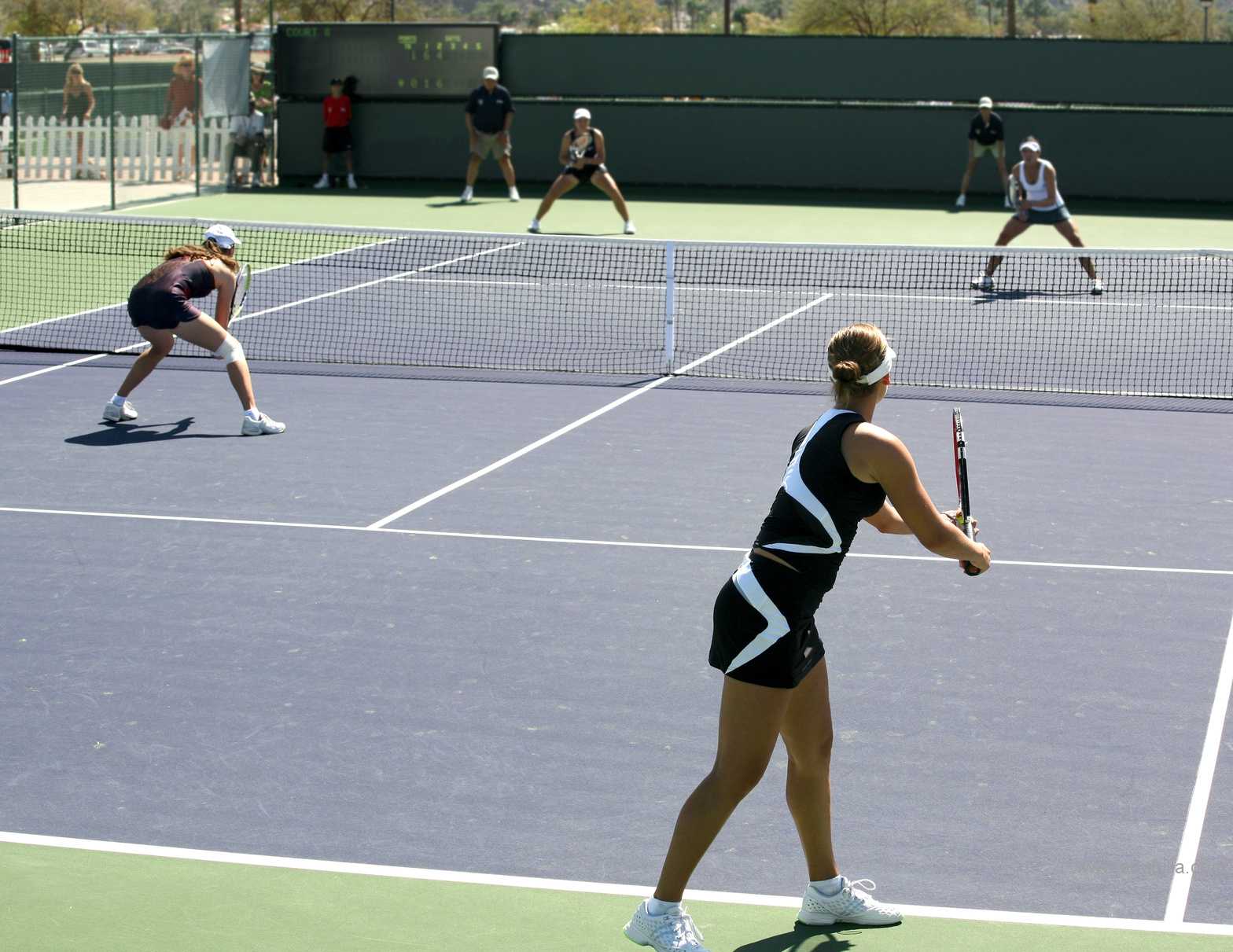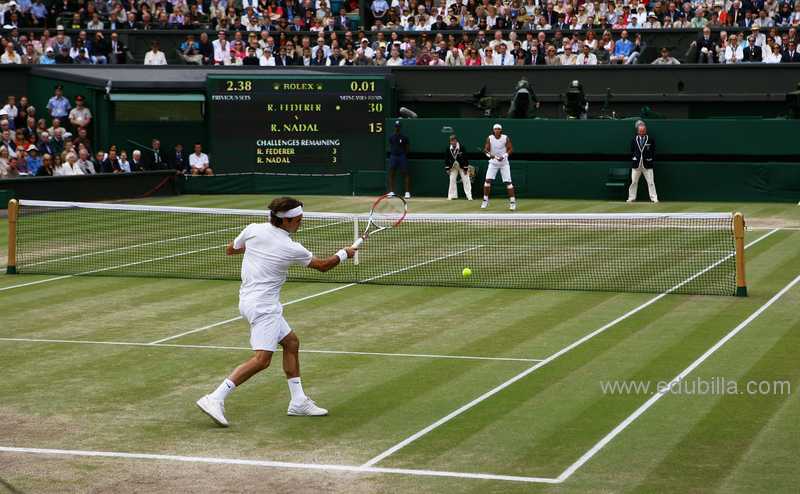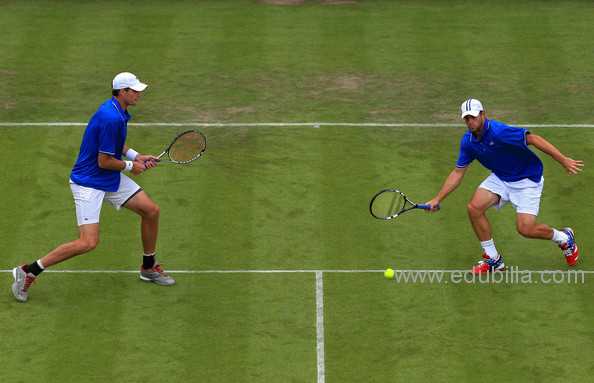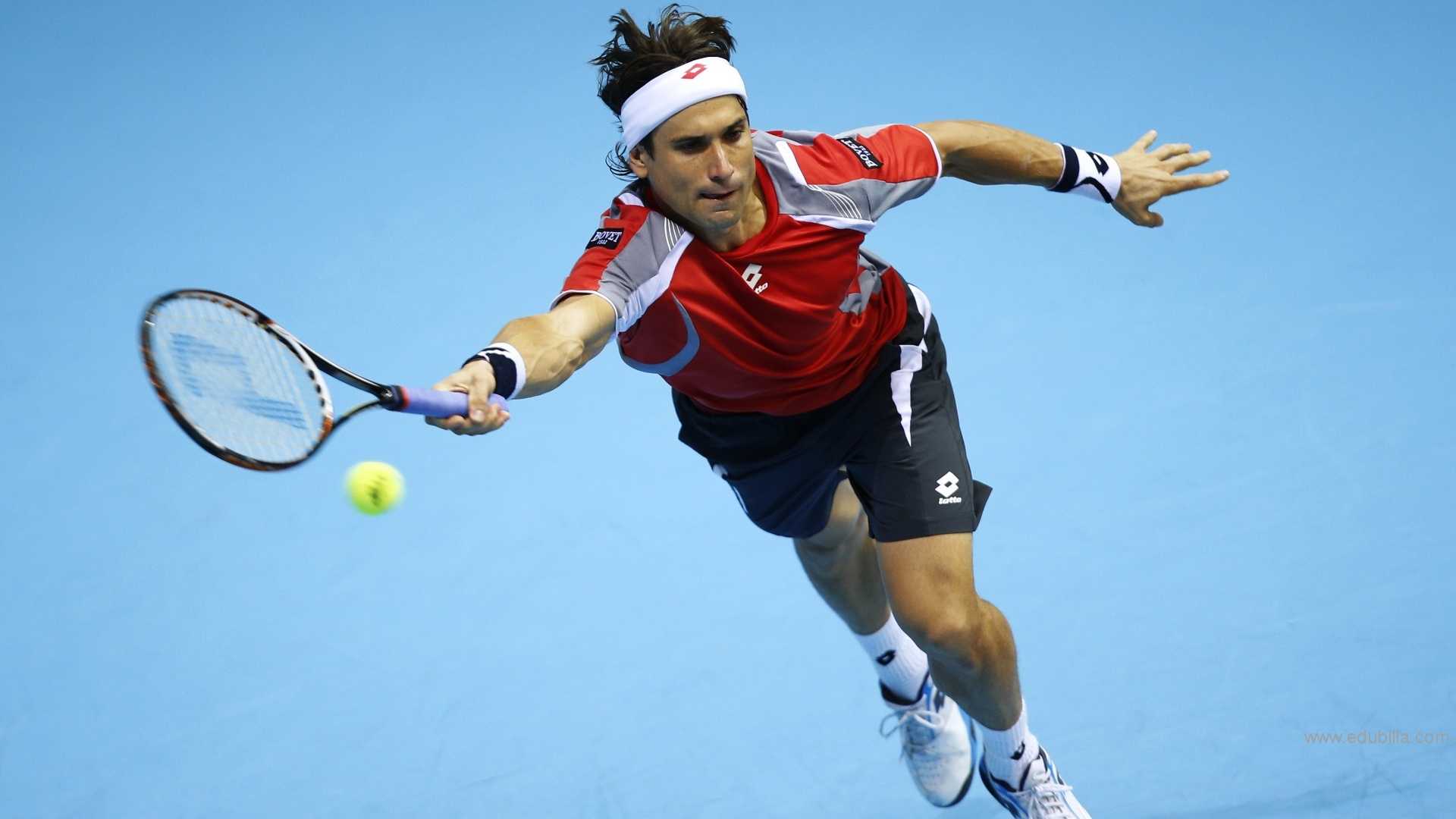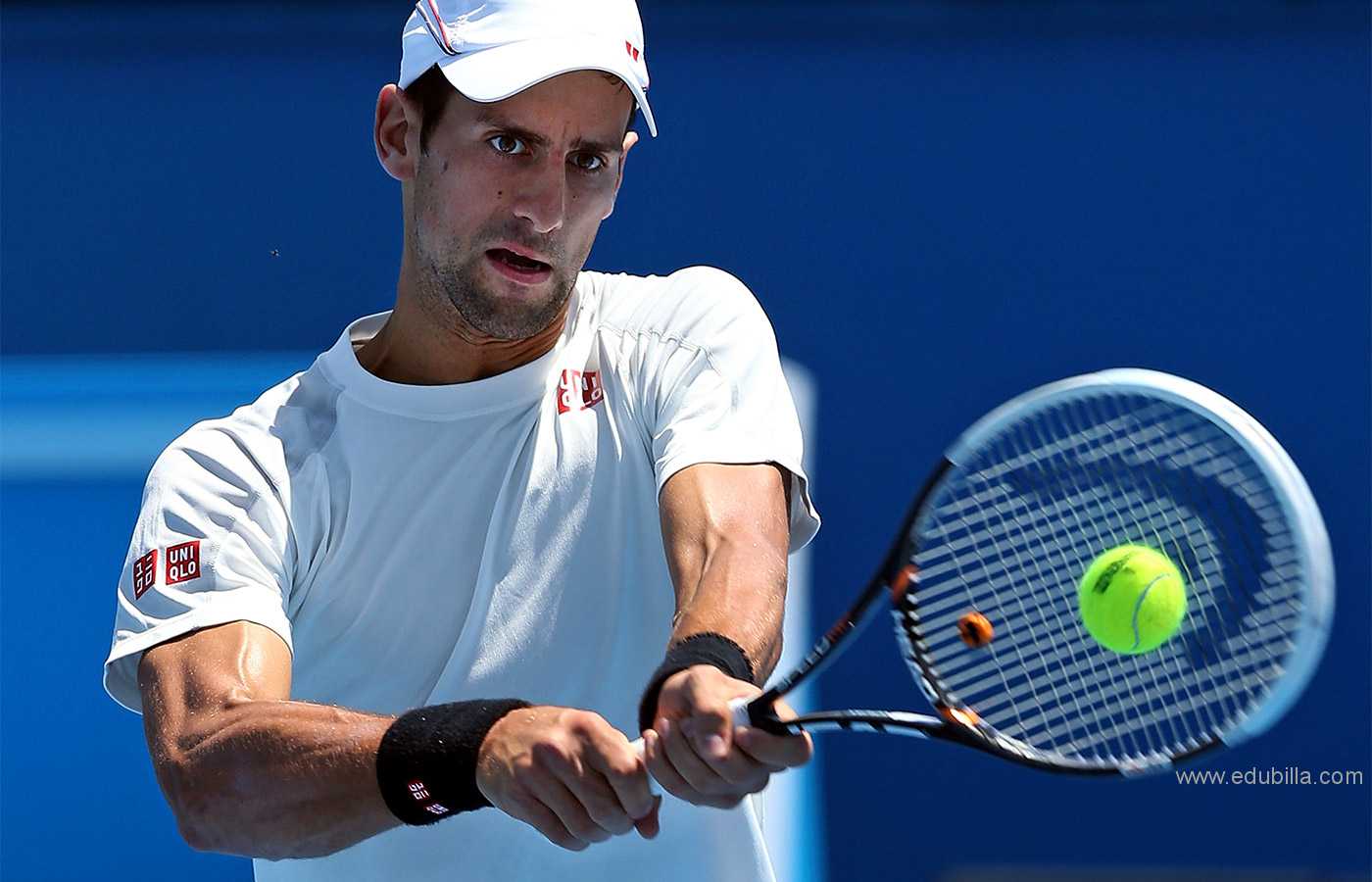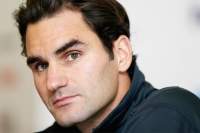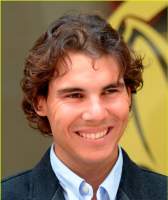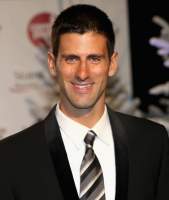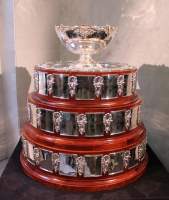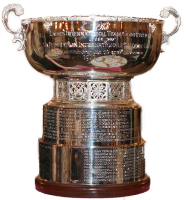
Overview Of Tennis
Tennis is a racquet sport that can be played individually against a single opponent (singles) or between two teams of two players each (doubles). Each player uses a racquet that is strung with cord to strike a hollow rubber ball covered with felt over or around a net and into the opponent's court. The object of the game is to play the ball in such a way that the opponent is not able to play a good return. The opponent who is unable to return the ball will not gain a point, while the opposite opponent will.
Tennis is an Olympic sport and is played at all levels of society and at all ages. The sport can be played by anyone who can hold a racquet, including wheelchair users. The modern game of tennis originated in Birmingham, England, in the late 19th century as "lawn tennis".It had close connections both to various field ("lawn") games such as croquet and bowls as well as to the older racquet sport of real tennis. During most of the 19th-century in fact, the term "tennis" referred to real tennis, not lawn tennis: for example, in Disraeli's novel Sybil (1845), Lord Eugene De Vere announces that he will "go down to Hampton Court and play tennis."
The rules of tennis have changed little since the 1890s. Two exceptions are that from 1908 to 1961 the server had to keep one foot on the ground at all times, and the adoption of the tie-break in the 1970s. A recent addition to professional tennis has been the adoption of electronic review technology coupled with a point challenge system, which allows a player to contest the line call of a point.
Tennis is played by millions of recreational players and is also a popular worldwide spectator sport. The four Grand Slam tournaments (also referred to as the "Majors") are especially popular: the Australian Open played on hard courts, the French Open played on red clay courts, Wimbledon played on grass courts, and the US Open played also on hard courts.
Court tennis is also known as royal tennis. It originated in France during the Middle Ages and became a favorite of British royalty, including Henry VIII. The progression from court tennis, which used an unresilient sheepskin ball filled with sawdust, sand, or wool, to lawn tennis depended upon invention of a ball that would bounce.
Game Rules
The Singles Game
Rule 1 - The Court
Rule 2 - Permanent Fixtures
Rule 3 - The Ball
Rule 4 - The Racket
Rule 5 - Server and Receiver
Rule 6 - Choice of Ends and Service
Rule 7 - The Service
Rule 8 - Foot Fault
Rule 9 - Delivery of Service
Rule 10 - Service Fault
Rule 11 - Second Service
Rule 12 - When to Serve
Rule 13 - The Let
Rule 14 - The "Let" in Service
Rule 15 - Order of Service
Rule 16 - When Players Change Ends
Rule 17 - The Ball in Play
Rule 18 - Server Wins Point
Rule 19 - Receiver Wins Point
Rule 20 - Player Loses Point
Rule 21 - Player Hinders Opponent
Rule 22 - Ball Falls on Line
Rule 23 - Ball Touches Permanent Fixtures
Rule 24 - A Good Return
Rule 25 - Hindrance of a Player
Rule 26 - Score in a Game
Rule 27 - Score in a Set
Rule 28 - Maximum Number of Sets
Rule 29 - Role of Court Officials
Rule 30 - Continuous Play and Rest Periods
Rule 31 - Coaching
Rule 32 - Changing Balls
The Doubles Game
Rule 34 - The Doubles Court
Rule 35 - Order of Service in Doubles
Rule 36 - Order of Receiving in Doubles
Rule 37 - Service Out of Turn in Doubles
Rule 38 - Error in Order of Receiving in Doubles
Rule 39 - Service Fault in Doubles
Rule 40 - Playing the Ball in Doubles
Detailed Basket Ball Rules Can Be Downloaded From Documents
Equipments Need For Tennis
Rackets:
The tennis racket is perhaps seen as the most important piece of equipment, and has traditionally attracted the most attention in terms of technological development.
One reason for this could be that the racket is not shared by the players and can be tailored to the physiology and playing style of the individual. That is, it is seen as having central importance in how the player performs.
Balls:
The ball, along with the racket, is arguably the most important piece of tennis equipment. The tennis ball must lie within the specifications laid down in the Rules of Tennis, while providing consistent playing properties and being sufficiently durable to withstand repeated high-speed impacts with the racket and surface.
Strings:
Although players may focus on getting the best racket frame they can, it will rarely make contact with the ball. It’s the interlaced pattern of string that does that, and so it plays an important role (albeit in combination with the racket frame) in determining the outcome of the shot.
During a typical shot, the strings impact the ball with such force that both deform extensively, yet within 5 milliseconds (5 thousandths of a second) the strings have recovered their original shape and the ball has left the strings (the ball continues to vibrate for a short time afterwards).
Footwear:
Tennis is played on a variety of surfaces, including clay, carpet, grass, and hard court. These main surfaces are reflected by the Grand Slam tournaments, which are played on hard court (US Open and Australian Open), red clay (Roland Garros), and grass (Wimbledon).
Net:
The net is attached between two poles and divides with an equal distance the two sides of the court. The Height of the net is in its centre of 0,914m and on its two sides of 1,07m.
History Of Tennis
The game of tennis (more properly known as lawn tennis) was developed in the 1870s from the game of royal or real tennis, which has been played for centuries. While both games are similar, in that they are both based on two or four players opposing each other from different sides of a net hitting a ball back and forth, the type and size of court, method of scoring, etc., are very different.
Predecessors:
Historians believe that the game's ancient origin lay in 12th century northern France, where a ball was struck with the palm of the hand.Louis X of France was a keen player of jeu de paume ("game of the palm"), which evolved into real tennis, and became notable as the first person to construct indoor tennis courts in the modern style. Louis was unhappy with playing tennis out of doors and accordingly had indoor, enclosed courts made in Paris "around the end of the 13th century".In due course this design spread across royal palaces all over Europe.In June 1316 at Vincennes, Val-de-Marne and following a particularly exhausting game, Louis drank a large quantity of cooled wine and subsequently died of either pneumonia or pleurisy, although there was also suspicion of poisoning.Because of the contemporary accounts of his death, Louis X is history's first tennis player known by name.Another of the early enthusiasts of the game was King Charles V of France, who had a court set up at the Louvre Palace.
It wasn't until the 16th century that racquets came into use, and the game began to be called "tennis", from the Old French term tenez, which can be translated as "hold!", "receive!" or "take!", an interjection used as a call from the server to his opponent.It was popular in England and France, although the game was only played indoors where the ball could be hit off the wall. Henry VIII of England was a big fan of this game, which is now known as real tennis.During the 18th century and early 19th century, as real tennis declined, new racquet sports emerged in England.
Further, the patenting of the first lawn mower in 1830, in Britain, is strongly believed to have been the catalyst, world-wide, for the preparation of modern-style grass courts, sporting ovals, playing fields, pitches, greens, etc. This in turn led to the codification of modern rules for many sports, including lawn tennis, most football codes, lawn bowls and others
Who invented lawn tennis?
An Englishman, Major Walter C. Wingfield, invented lawn tennis (1873) and first played it at a garden party in Wales. Called "Sphairistiké" [Gr., = ball playing] by its inventor, the early game was played on an hourglass-shaped court, widest at the baselines and narrowest at the net. In creating the new sport, Wingfield borrowed heavily from the older games of court tennis and squash racquets and probably even from the Indian game of badminton.
Etymology:
The word "Tennis" came into use in English in the mid-13th century from Old French, via the Anglo-Norman term Tenez, which can be translated as "hold!", "receive!" or "take!". A call from the server to his opponent indicating that he is about to serve.The first known appearance of the word in English literature is by poet John Gower in his poem titled 'In Praise of Peace' dedicated to King Henry IV and composed in 1400; "Of the tenetz to winne or lese a chase, Mai no lif wite er that the bal be ronne". (Whether a chase is won or lost at tennis, Nobody can know until the ball is run)
Origin Of Tennis
Most historians believe that tennis originated in the monastic cloisters in northern France in the 12th century, but the ball was then struck with the palm of the hand hence the name jeu de paume ("game of the palm").
The First Tennis Court:
Real Tennis Court building at Falkland Palace, housing the world's oldest tennis court and Falkland Palace Royal Tennis Club.The Falkland Palace Royal Tennis Club (also previously called the Falkland Palace Real Tennis Club) organizes play at the real tennis court in the gardens of Falkland Palace, Fife, Scotland.
Real tennis:
The term real was first used by journalists in the early 20th century as a retronym to distinguish the ancient game from modern lawn tennis (even though the latter sport is seldom contested on lawns these days outside the few social-club-managed estates such as Wimbledon). Players of real tennis often call the game tennis, while continuing to refer to the more widely played derivative as lawn tennis
First Tennis Club:
Between 1859 and 1865 Harry Gem and his friend Augurio Perera developed a game that combined elements of racquets and the Basque ball game pelota, which they played on Perera's croquet lawn in Birmingham, England, United Kingdom.In 1872, along with two local doctors, they founded the world's first tennis club in Leamington Spa.
Terminology:
-Tennis comes from the French tenez, the plural imperative form of the verb tenir, to hold, meaning "hold!", "receive!" or "take!", an interjection used as a call from the server to his opponent to indicate that he is about to serve.
-Racket derives from the Arabic rakhat, meaning the palm of the hand.
-Deuce comes from a deux le jeu, meaning "to both is the game" (that is, the two players have equal scores).
-The origin of the use of Love for zero is disputed. It is possible that it derives from "l'oeuf", the French word for "egg", representing the shape of a zero. Another possibility is that it derives from the Dutch expression "iets voor lof doen", which means to do something for praise, implying no monetary stakes.
-The reason for the numbering of scores being "15", "30" and "40" is unknown. Historical sources suggest the system was originally 15, 30, 45 with the 45 simplified to 40 over time. Common theories are that it originated from the quarters of a clock, or from gambling stakes.
The First Tennis Tournament:
The inaugural 1877 Wimbledon Championship was a men's tennis tournament held at the All England Croquet and Lawn Tennis Club in London. It was the world's first official lawn tennis tournament, as well as the inaugural edition of what was later to be called a Grand Slam tournament or Major.
Wimbledon is considered the world's premier tennis tournament and the priority of the Club is to maintain its leadership. To that end a long-term plan was unveiled in 1993, intended to improve the quality of the event for spectators, players, officials and neighbours.
Stage one (1994–1997) of the plan was completed for the 1997 championships and involved building the new No. 1 Court in Aorangi Park, a broadcast centre, two extra grass courts and a tunnel under the hill linking Church Road and Somerset Road.
Stage two (1997–2009) involved the removal of the old No. 1 Court complex to make way for the new Millennium Building, providing extensive facilities for players, press, officials and members, and the extension of the West Stand of the Centre Court with 728 extra seats.
Stage three (2000–2011) has been completed with the construction of an entrance building, club staff housing, museum, bank and ticket office
Governing Bodies
International Tennis Federation (ITF):
The International Tennis Federation (ITF) is the governing body of world tennis, made up of 210 national tennis associations or corresponding organizations of independent countries or territories.
It was established as the International Lawn Tennis Federation (ILTF) by 12 national associations meeting at a conference in Paris, France on 1 March 1913, and discussions on rules and policy continued through 1923.
It was at this time that two compromises were reached: the title 'world championships' would be abolished and wording would be 'for ever in the English language'.In 1924 it became the officially recognised organisation with authority to control lawn tennis throughout the world, with official 'ILTF Rules of Tennis'. In 1977 it dropped the word 'lawn' from its title, recognising that most tennis was no longer played on grass.
Timeline
1913
The International Lawn Tennis Federation (ILTF) was founded on 1 March at the first General Conference in Paris, when 15 nations became the inaugural members.
1914
Of the nations allotted voting shares of the ILTF, three nations, Norway, Canada and USA decided not to accept membership at that time and prior to the 1914 meeting declared that they would not take up the votes.
1919
After the interruption of World War I, which broke out in 1914, the ILTF continued its work, although there were only 10 member nations retained after the war.
1922
The International Rules Board was appointed by the Advisory Committee (Committee of Management) to overcome the problem of recognising the ILTF had the exclusive right to alter and control the rules of the game.
1923
At the Annual General Meeting (AGM) on 16 March in Paris, the official ILTF ‘Rules of Tennis’ were adopted with public effect from 1 January 1924. USA became an affiliated member of the ILTF. The title World Championship was also dropped at this meeting but a new category of Official Championship was created for events in Great Britain, France, USA and Australia – today’s Grand Slam events.
1924
The ILTF became the officially recognised organisation with authority to control lawn tennis throughout the world.
1933
The Committee of Management took over from the Advisory Committee as the elected governing head of the ILTF.
1934
A specially convened committee was set up to discuss the differences between professionals and amateurs, and the ability for amateurs to claim expenses over eight weeks of the year. The regulations governing amateurism had been defined at the Annual General Meeting of the ILTF in 1920.
1939
The total number of affiliated nations had risen to 59. During World War II, because of the devaluation of the French Franc and the imminent invasion of Switzerland, the funds of the ILTF were transferred to Great Britain. From that time onwards the ILTF has been run from London.
1946
The first post-war meeting was held in London at the Savoy hotel on 5 July. In total, 23 nations were represented with various nations being expelled from the ILTF in the aftermath of the war. Over the years, the nations were reinstated but others came and went with the rise and fall of other global political issues.
1948
The International Ball Committee was set up to enquire into the standardisation of tennis balls throughout the world. It was the Committee’s recommendation that “the ILTF should endeavour to procure an apparatus designed and constructed which will enable balls to be readily and accurately tested at speeds at which the game is played."
1951
The eight-week rule (permitting an amateur to claim expenses for up to eight-weeks of the year) was relaxed to 210 days, allowing amateurs to claim expenses for competing in tournaments. By 1958, the ILTF was concerned that this relaxation of the rules was “encouraging players to concentrate on the game of tennis to the exclusion of all gainful occupation."
1963
The ILTF celebrated its 50th anniversary by launching the Federation Cup, an international women's team competition designed to match the men's equivalent, Davis Cup, which had been in existence since 1900, but not under the auspices of the ILTF.
1968
After ten years of division and struggle within the ILTF an emergency meeting was called in Paris on 30 March, when 47 nations agreed in principle to the issue of "Open" tennis. A breakaway tennis circuit was organised called World Championship Tennis (WCT), running in opposition to the official ILTF circuit. The ILTF received sponsorship to organise Grand Prix tournaments allowing players to compete openly and legally for money.
1970
The first change in scoring came when an experiment was authorised to test the tiebreak. By 1974, the tiebreak had been sanctioned as a permitted alternative to the scoring system, then at the AGM in 1988 it was decided the tiebreak system should be adopted for Davis Cup matches from 1989 onwards.
1971
The ILTF decreed at the AGM in Italy that no player contracted to play WCT could play in any event authorised by a National Association. This meant that John Newcombe could not defend his Wimbledon title that year. In March 1972, the WCT and ILTF finally joined forces to promote a unified circuit for the benefit of all players.
1972
As television coverage of tennis events grew, the use of yellow balls was allowed after a two year experimental period - white balls were the requirement up until this time.
1973
There was a dispute between the Association of Tennis Professionals (ATP) and the ILTF because of the nine-month suspension imposed on Yugoslavian Nikki Pilic over his non-appearance for his country in their Davis Cup match against New Zealand. The penalty was reduced to one-month following an emergency meeting but the ATP announced that their members would boycott Wimbledon to show their strength. Eighty players withdrew from the 1973 Wimbledon Championships.
1975
The Women’s International Professional Tennis Council (WIPTC) was formed and operated under a joint secretariat shared between the ILTF and the Women’s Tennis Association (WTA). It also had representatives from the tournaments and sponsors. The purpose of the Council was to promote, control and govern the organisation and development of the women’s professional circuit throughout the world.
1977
A sad moment in some people’s minds: 100 years after the start of the Wimbledon Championships the ILTF had a change of title, dropping the word “lawn” and becoming the International Tennis Federation (ITF). The ITF also started to monitor new concepts in stringing after complaints about a double-strung racket began to emerge.
1978
The first ITF World Champions were announced, Chris Evert and Bjorn Borg. They were chosen by two separate panels of former players.
1979
Davis Cup nations asked the ITF to assume responsibility for the Davis Cup competition, to organise and run the event. Davis Cup had been in existence since 1900 but was not controlled by the ILTF, but rather by a Committee of Davis Cup nations.
1981
NEC became the title sponsor of Davis Cup, enabling prize money to be given and coinciding with a 16-strong World Group being established. NEC also became the sponsor of the Federation Cup, until 1994.
1987
The ITF moved from Wimbledon to Barons Court, west London, nearby to Queen's Club.
1988
Tennis returned to the Olympic Games in Seoul, Korea as a full medal sport after an absence of 64 years, in the year of the ITF's 75th anniversary and after diligent work by ITF President Philippe Chatrier and General Secretary David Gray.
1999
Davis Cup celebrated its 100th anniversary.
2001
A record 142 nations entered Davis Cup
2002
BNP Paribas took over as Davis Cup's title sponsor, a year after it first linked up with the competition as an Official Partner.
2005
BNP Paribas increased its partnership with the ITF by also becoming the title sponsor of Fed Cup.
2006
After three years of research by the ITF, electronic line-calling made its official debut at the Hopman Cup in Perth.
2007
The ITF launched its Tennis Play & Stay campaign, a recruitment and retention programme for start-up players, and also Tennis iCoach, an online resource for tennis coaches worldwide. The Tennis Anti-Doping Programme became exclusively managed by the ITF.
2008
The ITF established an official Beach Tennis Tour consisting of 14 tournaments, which in four years grew to over 100.
2009
Players competing in Davis Cup's World Group and World Group play-offs began earning ATP ranking points, marking the first time that they could improve their individual ranking when representing their nation in Davis Cup.
The ITF/ATP/WTA/Grand Slam Committee adopted the new Tennis Anti-Corruption Programme, operated by the Tennis Integrity Unit, to monitor any potential match-fixing in tennis.
2012
The ITF’s flagship competition reached its milestone when Prague played host to the 100th Davis Cup Final in which Czech Republic defeated Spain.
2013
210 member nations came together to celebrate 100 years of the ITF. Fed Cup celebrated 50 years of competition. The ITF launched World Tennis Day on 4 March in partnership with sports promoter StarGames.
Function:
The ITF operates the three major national team competitions in the sport, the Davis Cup for men, the Fed Cup for women and the Hopman Cup, mixed teams. The ITF sanctions the four grand slams: the Australian Open, the French Open, Wimbledon, and the US Open.
Structuring the game:
The ITF structures the game by sanctioning the following international circuits and events:
- ITF Junior Circuit
- ITF Men’s Circuit
- ITF Women’s Circuit
- ITF Seniors Circuit
- ITF Beach Tennis Tour
- UNIQLO Wheelchair Tennis Tour
- Hopman Cup
Developing the game:
The ITF develops the games through its worldwide development programme. The Grand Slam Development Fund and ITF invest more than US $4 million per annum into initiatives for the growth of tennis around the world
Promoting the game:
The ITF promotes tennis through television, PR, marketing, event management and sponsorship. The official websites of the ITF also reach out to players and fans around the world, including ITFtennis.com, DavisCup.com and FedCup.com.
To Visit ITF Click Here.
Awards Related To Tennis
World Champions Dinner:
The ITF World Champions Dinner is an annual event that takes place in Paris during the Roland Garros fortnight.
The celebration brings together over 400 members of the tennis family to honour the ITF World Champions, who are recognised for their outstanding performance from the previous year.
Serbia's Novak Djokovic and USA's Serena Williams scooped the top men's and women's singles awards after their performances during the 2014 season, while the best doubles teams, juniors and wheelchair players were also commended.
ATP World Tour Awards:
This is a list of all the awards given by the ATP World Tour to players (and others) of particular distinction during a given season.
1 Player of the Year
2 Doubles Team of the Year
3 Most Improved Player
4 ATP Star of Tomorrow
5 Comeback Player of the Year
6 ATPWorldTour.com Fans' Favorite
7 ATPWorldTour.com Fans' Favorite Team
8 Stefan Edberg Sportsmanship Award
9 Arthur Ashe Humanitarian of the Year
10 Tournament of the Year
11 TCC Monthly Award
AEGON Awards:
The Aegon British Tennis Awards are a set of monthly awards that are presented to current tennis players, who represent Great Britain and are deemed to have made the best performance, and/or contribution to British tennis.
They were first awarded for January 2009.Each month three categories are presented to the recipients of Senior Player, Junior Player and Coach.
The Player and Junior Player Awards are selected by the performance board in the Player Team meeting at the National Tennis Centre. The board decide this from nominations given by top LTA national coaches, taking into consideration a combination of ranking improvements, outstanding performance and significant results.
The Coach of the Month is selected by the Head of Coaching and his team from the nominations put forward by LTA Licensed coaches. The winning coach being deemed to have had the greatest impact on British Tennis in the previous month.
Best Female Tennis Player ESPY Award:
The Best Female Tennis Player ESPY Award has been presented annually since 1993 to the professional female tennis player adjudged to be the best in a given calendar year.
Between 1993 and 2004, the award voting panel comprised variously fans; sportswriters and broadcasters, sports executives, and retired sportspersons, termed collectively experts; and ESPN personalities, but balloting thereafter has been exclusively by fans over the Internet from amongst choices selected by the ESPN Select Nominating Committee.
Through the 2001 iteration of the ESPY Awards, ceremonies were conducted in February of each year to honor achievements over the previous calendar year; awards presented thereafter are conferred in June and reflect performance from the June previous
Best Male Tennis Player ESPY Award:
The Best Male Tennis Player ESPY Award has been presented annually since 1993 to the professional male tennis player adjudged to be the best in a given calendar year.
Between 1993 and 2004, the award voting panel comprised variously fans; sportswriters and broadcasters, sports executives, and retired sportspersons, termed collectively experts; and ESPN personalities, but balloting thereafter has been exclusively by fans over the Internet from amongst choices selected by the ESPN Select Nominating Committee.
Through the 2001 iteration of the ESPY Awards, ceremonies were conducted in February of each year to honor achievements over the previous calendar year; awards presented thereafter are conferred in June and reflect performance from the June previous
Coupe des Mousquetaires:
La Coupe des Mousquetaires (English: The Musketeers' Trophy) is the trophy awarded to the winner of the Men's Singles competition at the French Open.
The trophy was created in its current form in 1981, after Philippe Chatrier, then president of the French Tennis Federation (FFT), offered jewellers in Paris the opportunity to redesign it
Golden Bagel Award:
The Golden Bagel Award is an award established in 2004 that honors the professional male tennis player who has handed out more "bagels" (sets won 6–0), than any other player on the circuit.Roger Federer holds the all-time record for most bagels in a single season with 18 going into the Tennis Master's Cup, and a total of 19 in 2006.
To qualify for the award, a player must be ranked in the top 8 or play in the year-end ATP World Tour Finals. The winner is the one who captures the most bagels between January 1 and the start of the ATP Finals. Davis Cup matches and incomplete sets are not counted. The Association of Tennis Professionals website is used as the definitive data source. Since 2007, in the event of a tie, the number of 'fries/breadsticks' (6-1 sets) determines the winner
International Tennis Hall of Fame:
The International Tennis Hall of Fame is located in Newport, Rhode Island, United States. The hall of fame honors players and contributors to the sport of tennis and includes a museum, grass tennis courts, an indoor tennis facility, and a court tennis (or real tennis) facility.
ITF World Champions:
The International Tennis Federation (ITF) designates a World Champion each year based on performances throughout the year, emphasising the Grand Slam tournaments,and also considering team events such as the Davis Cup and Fed Cup.Men's and women's singles champions were first named in 1978; the title is now also awarded for doubles, wheelchair, and junior players
Russian Cup:
The Russian Cup is an annual major national Russian sports award given to tennis players, coaches, companies and other organizations and people that contributed in the development of that sport in Russia. The cup was established in 1994 by then-Vice President of the Russian Tennis Federation Dmitry Vikharev and the President of IC Arman. It was organized by Anatoly Gusev in the following two years, and after his death in 1996 his wife Lyudmila Guseva and businessman Alexander Cherkasov continued its organization.
Venus Rosewater Dish:
The Venus Rosewater Dish is the Ladies' Singles Trophy awarded at The Championships, Wimbledon, and was first presented to the Champion in 1886.
A Rosewater dish is a ceremonial platter used after eating to catch rosewater poured from warm or cold ewers over the hands to wash them, a daily ceremony in England. Later, such dishes were used for display only. This one includes an image of the goddess Venus. A salver (Latin salva, save from risk) was originally used by food tasters who tested food for poison. A rosewater dish was considered a salver by extension. These dishes were made of pewter, silver, or gold.
Sample Documents Of Tennis
-Viswanathan Anan

